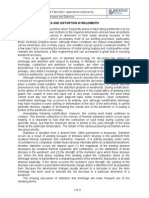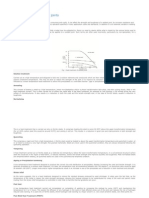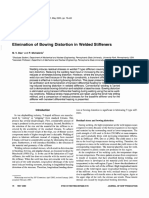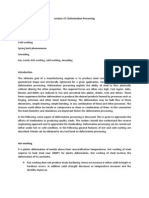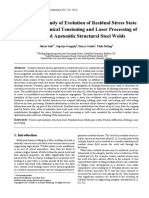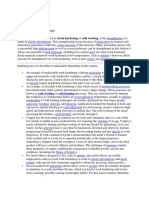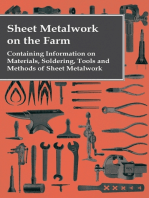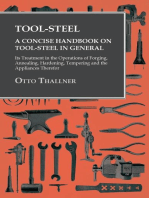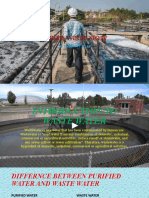PWHT
PWHT
Uploaded by
Zakariya SaifCopyright:
Available Formats
PWHT
PWHT
Uploaded by
Zakariya SaifCopyright
Available Formats
Share this document
Did you find this document useful?
Is this content inappropriate?
Copyright:
Available Formats
PWHT
PWHT
Uploaded by
Zakariya SaifCopyright:
Available Formats
Stress-Relief Heat Treating of Steel
Introduction
STRESS-RELIEF HEAT TREATING is used to relieve stresses that remain
locked in a structure as a consequence of a manufacturing sequence. This
definition separates stress-relief heat treating from postweld heat treating in that
the goal of postweld heat treating is to provide, in addition to the relief of residual
stresses, some preferred metallurgical structure or properties (Ref 1, 2). For
example, most ferritic weldments are given postweld heat treatment to improve the
fracture toughness of the heat-affected zones (HAZ). Moreover, austenitic and
nonferrous alloys are frequently postweld heat treated to improve resistance to
environmental damage.
Stress-relief heat treating is the uniform heating of a structure, or portion thereof,
to a suitable temperature below the transformation range (Ac1 for ferritic steels),
holding at this temperature for a predetermined period of time, followed by
uniform cooling (Ref 2, 3). Care must be taken to ensure uniform cooling,
particularly when a component is composed of variable section sizes. If the rate of
cooling is not constant and uniform, new residual stresses can result that are equal
to or greater than those that the heat-treating process was intended to relieve.
Stress-relief heat treating can reduce distortion and high stresses from welding that
can affect service performance. The presence of residual stresses can lead to stress-
corrosion cracking (SCC) near welds and in regions of a component that has been
cold strained during processing. Furthermore, cold strain per se can produce a
reduction in creep strength at elevated temperatures.
Residual stresses in a ferritic steel cause significant reduction in resistance to
brittle fracture. In a material that is not prone to brittle fracture, such as an
austenitic stainless steel, residual stresses can be sufficient to provide the stress
necessary to promote SCC even in environments that appear to be benign (Ref 4).
Sources of Residual Stress
There are many sources of residual stress; they can occur during processing of the
material from ingot to final product form (Ref 4, 5). Residual stresses can be
generated during rolling, casting, or forging; during forming operations such as
shearing, bending, drawing, and machining; and during fabrication, in particular,
welding. Residual stresses are present whenever a component is stressed beyond its
elastic limit and plastic flow occurs. Additional information on residual
stresses can be found in the article "Defects and Distortion in Heat-Treated Parts"
in this Volume.
Bending a bar during fabrication at a temperature where recovery cannot occur
(cold forming, for example) will result in one surface location containing residual
tensile stresses, whereas a location 180° away will contain residual compressive
stresses (Ref 6).
Quenching of thick sections results in high residual compressive stresses on the
surface of the material. These high compressive stresses are balanced by residual
tensile stresses in the internal areas of the section (Ref 7).
Grinding is another source of residual stresses; these can be compressive or tensile
in nature, depending on the grinding operation. Although these stresses tend to be
shallow in depth, they can cause warping of thin parts (Ref 8).
Welding. The cause of residual stresses that has received the most attention in the
open literature is welding. The residual stresses associated with the steep thermal
gradient of welding can occur on a macroscale over relatively long distances
(reaction stresses) or can be highly localized (microscale) (Fig. 1). Welding usually
results in localized residual stresses that approach levels equal to or greater than
the yield strength of the material at room temperature.
You might also like
- Heat Treatment of Welded JointsDocument11 pagesHeat Treatment of Welded JointsMuhammed SulfeekNo ratings yet
- Annealing Heat Treatment PDFDocument5 pagesAnnealing Heat Treatment PDFsmani170No ratings yet
- Hydrogen CrackingDocument9 pagesHydrogen CrackingMuhammed SulfeekNo ratings yet
- 3.stress ReliefDocument2 pages3.stress ReliefRajeevSangamNo ratings yet
- 4.3. Residual Stresses and Distortion in WeldmentsDocument11 pages4.3. Residual Stresses and Distortion in WeldmentsprokulisNo ratings yet
- Welding Technology - Pre and Post Weld Heat TreatDocument19 pagesWelding Technology - Pre and Post Weld Heat TreatNowsherwan MazariNo ratings yet
- Reduction of Residual StressDocument19 pagesReduction of Residual StressSteve HornseyNo ratings yet
- (Doi 10.1016 - B978-0!08!096532-1.01209-7) Ericsson, T. - Comprehensive Materials Processing - Residual Stresses Produced by Quenching of Martensitic SteelsDocument28 pages(Doi 10.1016 - B978-0!08!096532-1.01209-7) Ericsson, T. - Comprehensive Materials Processing - Residual Stresses Produced by Quenching of Martensitic SteelsmohamadNo ratings yet
- Residual Stresses in Weld JointsDocument8 pagesResidual Stresses in Weld Jointshayder1920No ratings yet
- Heat Treatment of Welded JointsDocument17 pagesHeat Treatment of Welded JointsErick HoganNo ratings yet
- Heat Treatment of Welded JointsDocument26 pagesHeat Treatment of Welded Jointslinhcdt3No ratings yet
- M 1.2.7 Heat Treatment of Base Materials and Welded JointDocument10 pagesM 1.2.7 Heat Treatment of Base Materials and Welded Jointdokumen qcNo ratings yet
- Weld Poster ExplainationDocument2 pagesWeld Poster ExplainationDaniel ThamNo ratings yet
- Heat Treatment of Welded JointsDocument4 pagesHeat Treatment of Welded JointskingstonNo ratings yet
- The Use of Heheat Straightening To Repair Damaged Steel StructuresDocument38 pagesThe Use of Heheat Straightening To Repair Damaged Steel Structuresjeanpaul CAYTANNo ratings yet
- TGN-D-04 Distortion Control in ShipbuildingDocument9 pagesTGN-D-04 Distortion Control in ShipbuildingKomkamol ChongbunwatanaNo ratings yet
- Elimination of Bowing Distortion in Welded StiffenersDocument8 pagesElimination of Bowing Distortion in Welded StiffenersHaris HartantoNo ratings yet
- Eliminating Post-Weld Heat Treatment in Repair Welding by Temper Bead TechniqueDocument9 pagesEliminating Post-Weld Heat Treatment in Repair Welding by Temper Bead TechniqueSyarief NahdiNo ratings yet
- Stresses in Repair Welding of High-Strength Steels-Part 2: Heat Control and Stress OptimizationDocument15 pagesStresses in Repair Welding of High-Strength Steels-Part 2: Heat Control and Stress OptimizationengineeringNo ratings yet
- Weldability of SteelsDocument5 pagesWeldability of SteelsKhalid El Masry100% (1)
- Pengembangan Energy Consumption To Forging and CastingDocument20 pagesPengembangan Energy Consumption To Forging and CastingRefky FNo ratings yet
- GN06 Post Weld Heat Treatment of Welded PDFDocument11 pagesGN06 Post Weld Heat Treatment of Welded PDFGregory Fenwick100% (1)
- Forge WeldingDocument2 pagesForge WeldingDamo Daran GNo ratings yet
- Reduction of distortion by using the low transformation temperatureDocument12 pagesReduction of distortion by using the low transformation temperatureigina paulNo ratings yet
- AB Forging EngDocument24 pagesAB Forging EngtetirichieNo ratings yet
- Cryogenic ProcessingDocument2 pagesCryogenic Processingmuthupecmec4908No ratings yet
- Residual StressesDocument6 pagesResidual StressesSaad khanNo ratings yet
- Post Weld Heat TreatmentDocument13 pagesPost Weld Heat Treatments4yekt1No ratings yet
- FormingDocument10 pagesFormingYashwanth D RNo ratings yet
- Elastic Limit Fatigue and CreepDocument11 pagesElastic Limit Fatigue and CreepmdirsanNo ratings yet
- Aug10 SteeSteellwise WebDocument3 pagesAug10 SteeSteellwise Webeng_ahmed_666No ratings yet
- Lecture 37Document4 pagesLecture 37Dharmendra KumarNo ratings yet
- AnchorDocument5 pagesAnchorpadalakirankumarNo ratings yet
- Heat Treatment of SteelsDocument9 pagesHeat Treatment of SteelsEhsan KhanNo ratings yet
- Tolerancias de FundicionDocument15 pagesTolerancias de FundicionSalvadorNo ratings yet
- 10 5923 J Jmea 20150501 05Document10 pages10 5923 J Jmea 20150501 05wajdiNo ratings yet
- Hot Dip Galvanized Information Sheet No.10: Avoiding DistortionDocument4 pagesHot Dip Galvanized Information Sheet No.10: Avoiding DistortionrawatanoopNo ratings yet
- Principles of WeldingDocument13 pagesPrinciples of WeldingMadhurimaMitraNo ratings yet
- Article - Stress Relieving Heat Treatments For Austenitic Stainless SteelsDocument2 pagesArticle - Stress Relieving Heat Treatments For Austenitic Stainless Steelsabhishek198327No ratings yet
- Brass AnnealingDocument11 pagesBrass AnnealingChristos KalavrytinosNo ratings yet
- Heat TreatmentDocument2 pagesHeat TreatmentUsman MuhammadNo ratings yet
- Heat Treatment of Steel 1516Document20 pagesHeat Treatment of Steel 1516s190149 ANUSURI LIKITHA SAI RAMA AKHILESHNo ratings yet
- January 2015 1422602600 88Document2 pagesJanuary 2015 1422602600 88DilipNo ratings yet
- Draft Strain HardeningDocument9 pagesDraft Strain HardeningRho AsaNo ratings yet
- Introduction CHAPTER 1Document12 pagesIntroduction CHAPTER 1Sp PatelNo ratings yet
- 1 What Causes Distortion?: Longitudinal ShrinkageDocument21 pages1 What Causes Distortion?: Longitudinal Shrinkage4romi89No ratings yet
- Metal Forming Processes Unit-IDocument9 pagesMetal Forming Processes Unit-IDimas Mahendra P BozerNo ratings yet
- Heat Treatment 8Document15 pagesHeat Treatment 8watersoul.nNo ratings yet
- Chapter 11-12Document19 pagesChapter 11-12TUFAYEL AHMED 1912002No ratings yet
- This Article Is About Metal Heat TreatmentsDocument48 pagesThis Article Is About Metal Heat TreatmentsquangluyNo ratings yet
- Def Stan 00-970Document11 pagesDef Stan 00-970stefan.vince536No ratings yet
- What Is PWHTDocument15 pagesWhat Is PWHTsanthoshm123098No ratings yet
- MaterialsciencereportDocument6 pagesMaterialsciencereporterosNo ratings yet
- Xie Auc2008Document13 pagesXie Auc2008klomps_jrNo ratings yet
- Hot Working & Cold WorkingDocument34 pagesHot Working & Cold Workingavutu_kunduruNo ratings yet
- Sheet Metalwork on the Farm - Containing Information on Materials, Soldering, Tools and Methods of Sheet MetalworkFrom EverandSheet Metalwork on the Farm - Containing Information on Materials, Soldering, Tools and Methods of Sheet MetalworkNo ratings yet
- Tool-Steel - A Concise Handbook on Tool-Steel in General - Its Treatment in the Operations of Forging, Annealing, Hardening, Tempering and the Appliances ThereforFrom EverandTool-Steel - A Concise Handbook on Tool-Steel in General - Its Treatment in the Operations of Forging, Annealing, Hardening, Tempering and the Appliances ThereforNo ratings yet
- Manual: Model W-075Document3 pagesManual: Model W-075Carlos BenitezNo ratings yet
- Geriatric Nursing Theories of AgingDocument8 pagesGeriatric Nursing Theories of AgingAi RouNo ratings yet
- Thesis Topics For Radiologic TechnologyDocument5 pagesThesis Topics For Radiologic Technologyiapesmiig100% (1)
- Problem Set in Combustion EngineeringDocument14 pagesProblem Set in Combustion EngineeringRosalyNo ratings yet
- House Hearing, 114TH Congress - Gendercide: China's Missing GirlsDocument98 pagesHouse Hearing, 114TH Congress - Gendercide: China's Missing GirlsScribd Government DocsNo ratings yet
- Grade-7-Research-I-Q2-WS-1 (3)Document5 pagesGrade-7-Research-I-Q2-WS-1 (3)danieledward.espera1213No ratings yet
- Jumbo DrillDocument4 pagesJumbo DrillJose Antonio Quispealaya HernandezNo ratings yet
- Carroll ResumeDocument3 pagesCarroll ResumealxsccrrxNo ratings yet
- Health Centre List 28-08-2022Document4 pagesHealth Centre List 28-08-2022raifatk2000No ratings yet
- Evolution: User ManualDocument7 pagesEvolution: User ManualHamza AliNo ratings yet
- M-0, Standard Practice Maintenance ManualDocument14 pagesM-0, Standard Practice Maintenance Manualjoshhoskins2001No ratings yet
- TTA Sublimation InkDocument4 pagesTTA Sublimation Inkde_kurNo ratings yet
- Bearing FailureDocument22 pagesBearing FailureMichael Andersen100% (1)
- Evaporator: Department of Chemical EngineeringDocument16 pagesEvaporator: Department of Chemical EngineeringspidyNo ratings yet
- PT Duporin SF Reactive DyesDocument6 pagesPT Duporin SF Reactive DyesAMTEX ParthNo ratings yet
- Data Backup and Disaster RecoveryDocument40 pagesData Backup and Disaster RecoveryDan BogdanNo ratings yet
- Journaling Jar Prompts For EntrepreneursDocument10 pagesJournaling Jar Prompts For EntrepreneursTapas BanerjeeNo ratings yet
- Aquaculture Products in VietnamDocument31 pagesAquaculture Products in VietnamRoni Kurniawan100% (1)
- A Tea StallDocument2 pagesA Tea StallFlora RokaiyaNo ratings yet
- Midea Package Units Approved Catalogue PDFDocument23 pagesMidea Package Units Approved Catalogue PDFAhmed Nasser ElaminNo ratings yet
- SAT EssayDocument2 pagesSAT EssayMinh Nguyen DucNo ratings yet
- EHRIG - Vol1 - Final Ethiopia Wond G PDFDocument400 pagesEHRIG - Vol1 - Final Ethiopia Wond G PDFNasradin AhmedNo ratings yet
- NO Nama Barang Expayer Jumlah Keterangan: Asal: Tanggal Faktur: Tanggal MasukDocument15 pagesNO Nama Barang Expayer Jumlah Keterangan: Asal: Tanggal Faktur: Tanggal MasukAsyfahNo ratings yet
- How To Reduce Maintenance CostsDocument1 pageHow To Reduce Maintenance CostsEyoh EffiongNo ratings yet
- Waste Water StoryDocument18 pagesWaste Water StoryAbishek ThiyagarajanNo ratings yet
- Ada 299473Document23 pagesAda 299473Paco MartinezNo ratings yet
- Topic 6 NCM 100 Skills Hygiene ComfortDocument24 pagesTopic 6 NCM 100 Skills Hygiene ComfortPearl IbisateNo ratings yet
- Tutorial 3BDocument6 pagesTutorial 3Bnexowa9068No ratings yet
- Test/Technology Test Method(s)Document4 pagesTest/Technology Test Method(s)food tecknologist0% (1)




